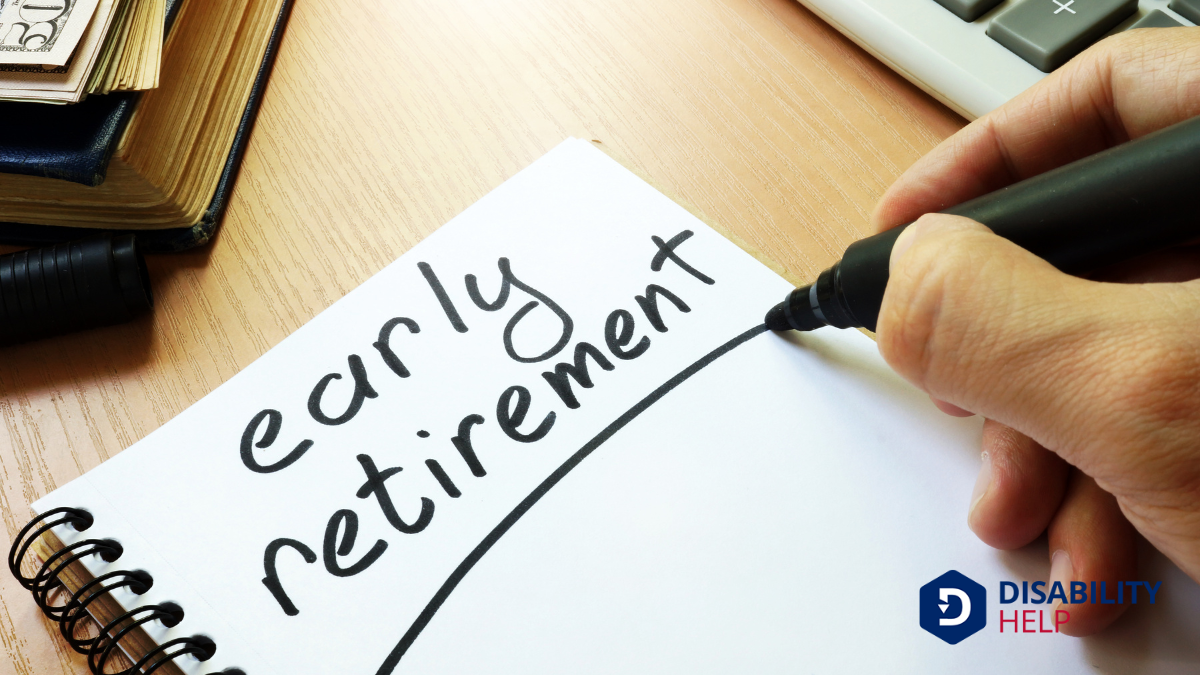Let's discuss the age at which Social Security Disability Insurance (SSDI)A U.S. government program that provides financial assistance to individuals who are unable to work d... smoothly shifts into regular Social Security benefits. As we approach full retirement age—between 66 and 67, depending on our birth year—this change happens automatically, without any need for us to act. Understanding this shift is essential for our financial planning. But how exactly does this affect what we receive each month, and what does it mean for our long-term financial health?
Key Takeaways
- SSDI automatically converts to regular Social Security benefits at full retirement age.
- Full retirement age varies between 66 and 67 based on birth year.
- No action is needed for the transition from SSDI to regular benefits.
- Payments continue uninterrupted during the transition from SSDI to retirement benefits.
- Awareness of the transition age aids in effective financial planning.
Understanding Social Security Disability Insurance (SSDI)
Social Security Disability InsuranceA form of insurance that provides income to individuals who are unable to work due to a disability. (SSDI) serves as an essential safety net for those of us who find ourselves unable to work due to a disability. We pay into this system through our payroll taxes, and it offers financial support when we need it the most.
Understanding how SSDI works can empower us to make informed decisions. SSDI provides monthly benefits to replace some of the income lost when we can't work. It's designed for those who've accumulated enough work credits, meaning we've worked and paid Social Security taxes for a significant period.
Criteria for Receiving SSDI Benefits

Let's explore what it takes to qualify for SSDI benefits.
First, we need to guarantee we've earned enough work credits through our employment history.
Then, we'll consider the disability determination process and any income and resource limits that might affect eligibility.
Work Credits Requirement
To qualify for Social Security Disability Insurance (SSDI), we need to understand the importance of work credits in determining eligibility. Work credits act as building blocks, earned through our employment history. We accumulate these credits by working and paying into Social Security through payroll taxes. Each year, we can earn up to four credits, depending on our annual income. Typically, earning one credit requires a set amount of income, which changes yearly.
For most of us, to qualify for SSDI, we need 40 credits, with 20 of those earned in the last ten years. However, if we’re younger, fewer credits might be required.
Understanding this requirement guarantees we’re better prepared when applying for SSDI benefits, knowing our work history matters.
Disability Determination Process
Having understood the importance of work credits for SSDI eligibility, we now focus on the disability determination process, which decides if we qualify for benefits.
This process involves several steps to evaluate our medical condition. First, we must demonstrate that our condition considerably limits our ability to perform basic work activities.
Next, Social Security reviews whether our condition is on its list of impairments. If it is, we typically qualify. If not, they assess whether we can still do our previous work or any other work.
This thorough evaluation guarantees that only those genuinely unable to work due to a disability receive benefits. By understanding each step, we’re better prepared to navigate the system and advocate for ourselves effectively.
Income and Resources Limits
Maneuvering the financial criteria for Social Security Disability Insurance (SSDI) benefits can be complex, but understanding the income and resources limits is essential.
Unlike Supplemental Security Income (SSI), SSDI doesn’t have strict resource limits because it’s based on our work history and not financial need. However, there’s a cap on how much we can earn while receiving benefits, known as Substantial Gainful Activity (SGA).
For 2023, if we earn more than $1,470 monthly (or $2,460 for blind individuals), we mightn't qualify as disabled. SSDI also considers unearned income, but it doesn’t factor into eligibility as heavily as with SSI.
The Age of Automatic Conversion to Retirement Benefits
When it comes to Social Security benefits, the alteration from disability to retirement benefits happens automatically at a specific age, which is vital for beneficiaries to understand.
We don't need to take any action; the change occurs seamlessly when we reach our full retirement age. For most of us, this age is between 66 and 67, depending on our birth year.
The Social Security Administration (SSA) guarantees that the switch from Social Security Disability Insurance (SSDI) to retirement benefits doesn't disrupt our financial stability. Our payments continue, reflecting this alteration, but it's important to know when this change happens.
Understanding this automatic conversion helps us plan for the future with confidence, knowing our benefits remain intact during this change.
Impact on Your Monthly Benefit Amount
While the shift from Social Security Disability Insurance (SSDI) to retirement benefits happens automatically, it doesn’t affect the amount of our monthly payments. Our benefits remain consistent because both SSDI and retirement benefits are calculated based on our earnings record.
When we reach full retirement age, our SSDI benefits simply change to retirement benefits, guaranteeing no reduction in the amount we receive. It's reassuring to know that this change doesn’t require any action on our part.
Understanding this process means we can plan our finances without worrying about sudden changes. The Social Security Administration guarantees that our benefits continue seamlessly, allowing us to focus on other aspects of our retirement planning.
Knowing this stability exists helps us feel more secure about our financial future.
Differences Between SSDI and Regular Social Security

As we explore further, it's important to recognize the key differences between Social Security Disability Insurance (SSDI) and regular Social Security benefits.
SSDI benefits are specifically for those unable to work due to a disability, requiring a sufficient work history and payment into Social Security through taxes. In contrast, regular Social Security benefits are designed for retirees, based on age and work credits accumulated over a lifetime.
When receiving SSDI, individuals may also qualify for MedicareA U.S. federal health insurance program for people aged 65 and older, and for some younger people wi... after a two-year waiting period. However, regular Social Security typically links to Medicare eligibility starting at age 65.
Both benefit types are calculated using an individual’s earnings record, but SSDI focuses on recent work, while regular Social Security considers lifetime earnings.
Understanding these differences is essential for maneuvering Social Security benefits.
Planning for the Transition to Retirement Benefits
For those of us approaching retirement, preparing for the shift from Social Security Disability Insurance (SSDI) to regular Social Security benefits is essential. As we near our full retirement age, typically between 66 and 67, SSDI automatically converts to retirement benefits.
Though the benefit amounts usually remain the same, understanding this change helps us plan for our financial future. We should verify that our personal information is current with the Social Security Administration (SSA) to avoid any disruptions.
Let’s review our benefits statement to confirm our expected income. It’s wise to create a retirement budget, considering any changes in expenses or additional income sources. Staying informed and proactive allows us to confidently navigate this change, verifying a smooth shift into our retirement years.
How Work History Affects Your Benefits
Let's take a closer look at how our work history plays a vital role in determining our Social Security benefits.
Work credits are essential, as they're the foundation upon which our benefits are calculated.
However, employment gaps can impact the number of credits we earn, potentially affecting our benefit amounts.
Work Credits Importance
Understanding how work history affects your benefits is essential when maneuvering through Social Security Disability and Regular Social Security. Our work credits play a significant role in determining eligibility for these benefits.
Think of work credits as building blocks; we earn them through our contributions to Social Security via payroll taxes. Typically, we need 40 credits, equivalent to about ten years of work, to qualify for retirement benefits.
However, the number needed for disability benefitsFinancial assistance provided to individuals who are unable to work due to a disability, such as Soc... can vary based on our age when we become disabled. By maintaining a consistent work history, we're ensuring we're eligible for benefits when needed.
It’s important to keep track of our earned work credits, as they directly influence the financial support we'll receive.
Impact of Employment Gaps
When we experience employment gaps, they can greatly impact the benefits we receive from Social Security. Our work history plays an important role in determining both Social Security Disability Insurance (SSDI) and regular retirement benefits. Each year we work and pay Social Security taxes, we earn credits. These credits are vital for calculating our benefits.
An inconsistent work history could mean fewer credits, potentially lowering the benefits we're eligible for. Additionally, the amount we earn also factors into the benefits calculation. Gaps might result in lower average earnings, which can reduce the monthly amount we receive.
It's important to understand how these gaps can affect us so we can plan accordingly and guarantee we're maximizing our future Social Security benefits.
Considerations for Early Retirement

As we navigate the complexities of retirement planning, considering early retirement requires careful assessment of its benefits and challenges.
Choosing to retire early might allow us more time to pursue personal interests and spend time with loved ones. However, it’s vital to weigh this against potential drawbacks. Early retirement often results in reduced Social Security benefits, which could impact our long-term financial stability.
We need to evaluate our savings and other income sources to guarantee they can sustain us throughout retirement. Additionally, retiring early might affect healthcare coverage, as Medicare eligibility usually begins at 65.
Let's make sure we make informed decisions by exploring all our options and consulting with financial advisors, so we can enjoy a fulfilling and secure retirement.
Managing Your Finances During the Transition
Shifting from Social Security Disability Insurance (SSDI) to regular Social Security benefits requires us to manage our finances carefully to secure financial stability.
As we approach this change, it's vital to review our budget and adjust to any variations in income. Let’s consider our monthly expenses and identify areas where we might need to cut back or allocate funds differently.
We should also understand the difference in benefit amounts and how it impacts our lifestyle.
Planning for any potential medical expenses or unexpected costs can prevent financial stress. Staying informed about the changes in benefits helps us plan effectively.
Resources for Navigating Social Security Changes
As we approach the shift from Social Security Disability to regular Social Security, understanding our benefits is essential.
There are a variety of resources available to help us navigate these changes, including government websites and local support organizations.
Let's explore how these tools can assist us in making informed decisions about our future.
Understanding Social Security Benefits
Steering through Social Security changes can be intimidating, yet understanding the benefits is crucial for securing financial stability in our later years. By grasping the basics of Social Security, we empower ourselves to make informed decisions.
Social Security Disability Insurance (SSDI) provides support when we're unable to work due to disability. Once we reach full retirement age, our SSDI benefits automatically convert to regular retirement benefits. This shift doesn’t require extra paperwork or action from us, simplifying the process. Knowing this guarantees we’re not caught off guard when the change occurs.
It’s also essential to comprehend how these benefits fit into our overall retirement plan. Familiarity with benefit structures enables us to anticipate income and manage our finances effectively.
Accessing Supportive Resources
Maneuvering the complexities of Social Security changes is easier when we comprehend where to find supportive resources.
Let’s start with the Social Security Administration (SSA) website, which offers detailed information and tools to calculate benefits and check eligibility. Local SSA offices and call centers provide personalized assistance, helping us address specific questions.
Additionally, nonprofit organizations like the National Disability RightsThe legal and human rights afforded to individuals with disabilities, often the focus of advocacy an... Network offer guidance and advocacyThe act of arguing in favor of, supporting, or defending the rights and interests of individuals or ... for those steering through these changes.
Online forums and community groups can also be valuable for shared experiences and advice.
We should consider consulting financial advisors specializing in Social Security to optimize our benefits.
Conclusion
As we approach full retirement age, it’s crucial to understand how our Social Security Disability Insurance shifts seamlessly into regular retirement benefits. This change doesn't require any action on our part, ensuring that our monthly payments continue uninterrupted. By staying informed about these changes, we can better manage our finances and plan for the future. Let's make sure we're prepared for this adjustment, keeping in mind how work history and early retirement choices might impact our benefits.






